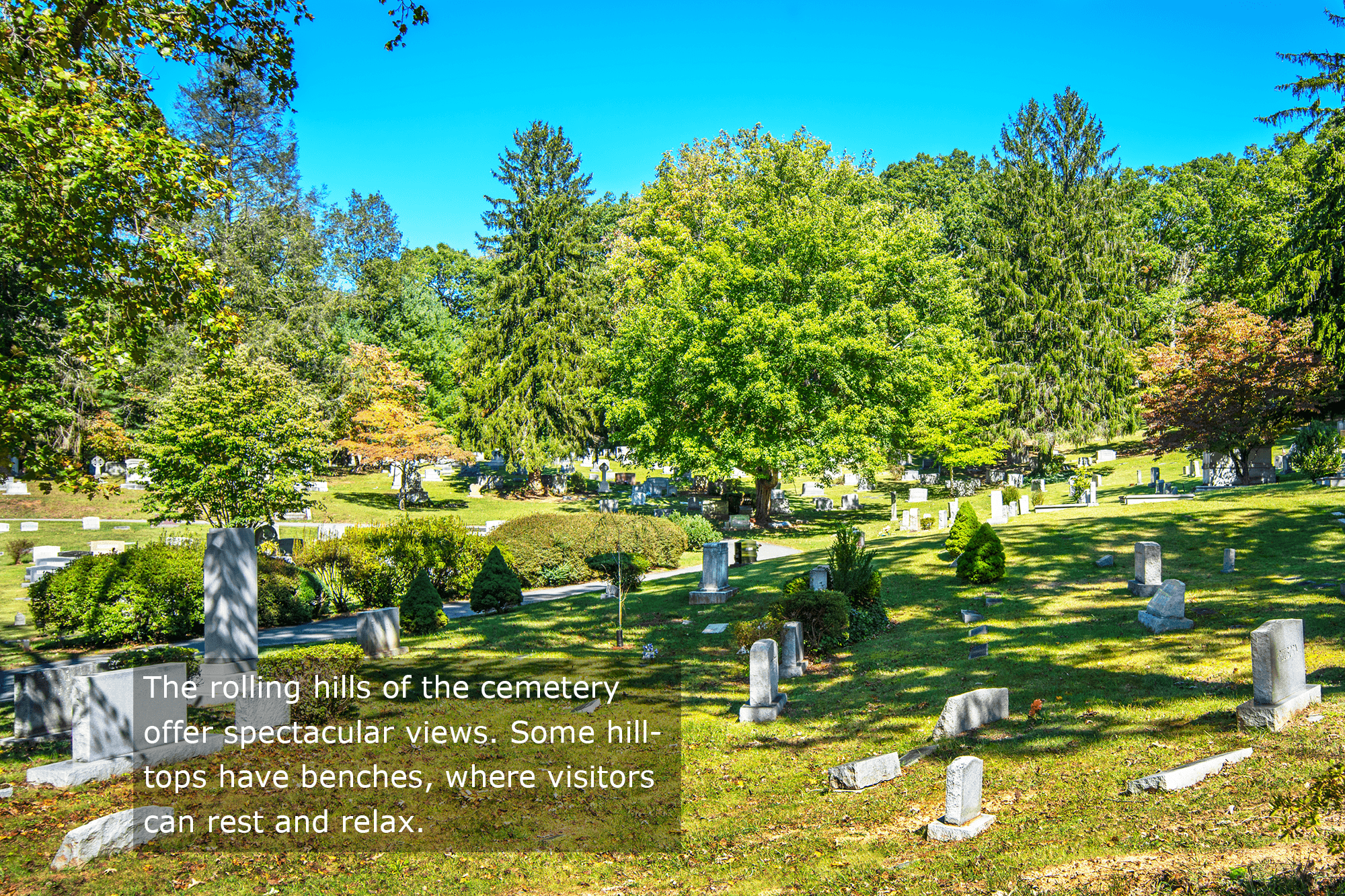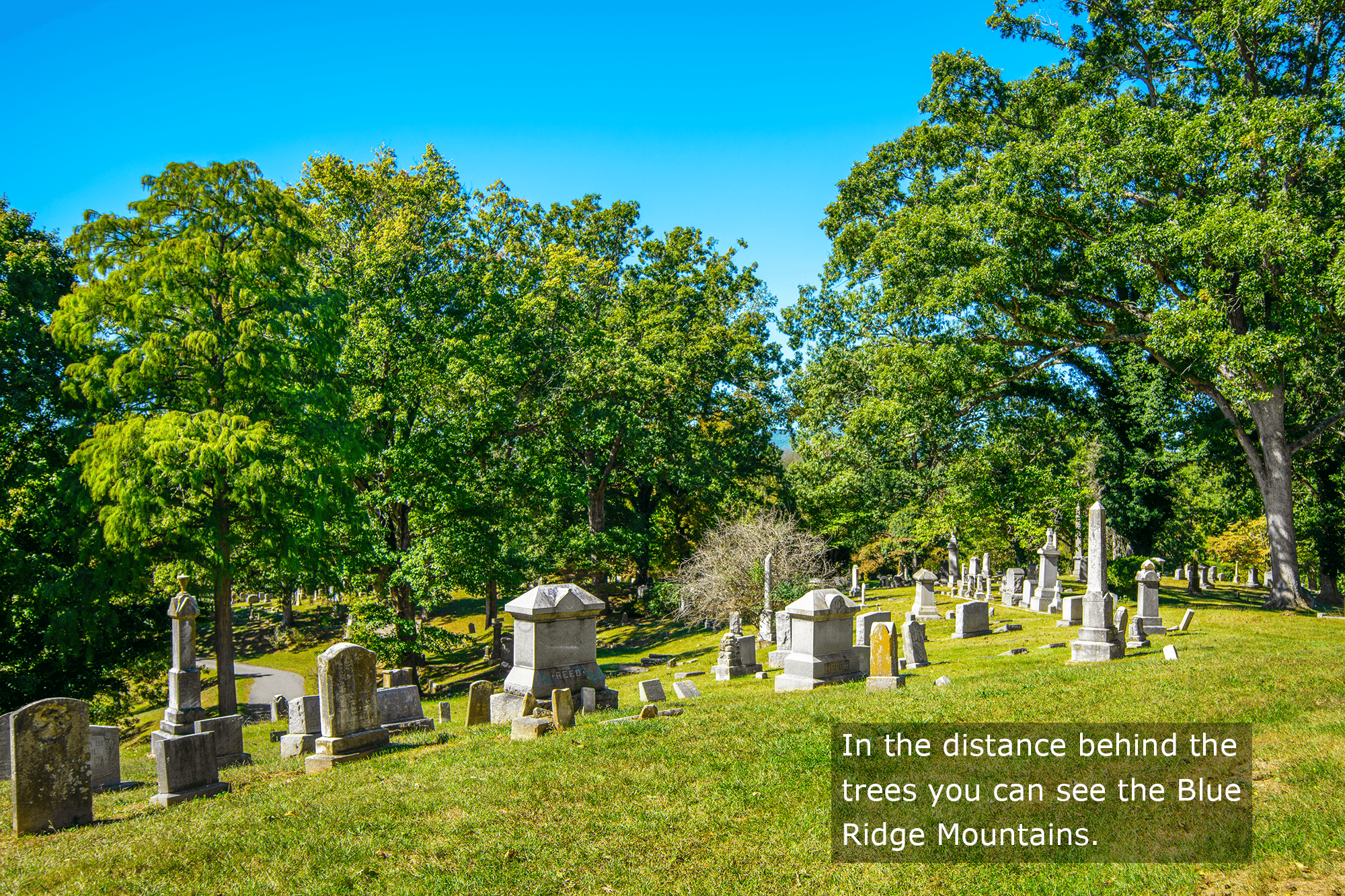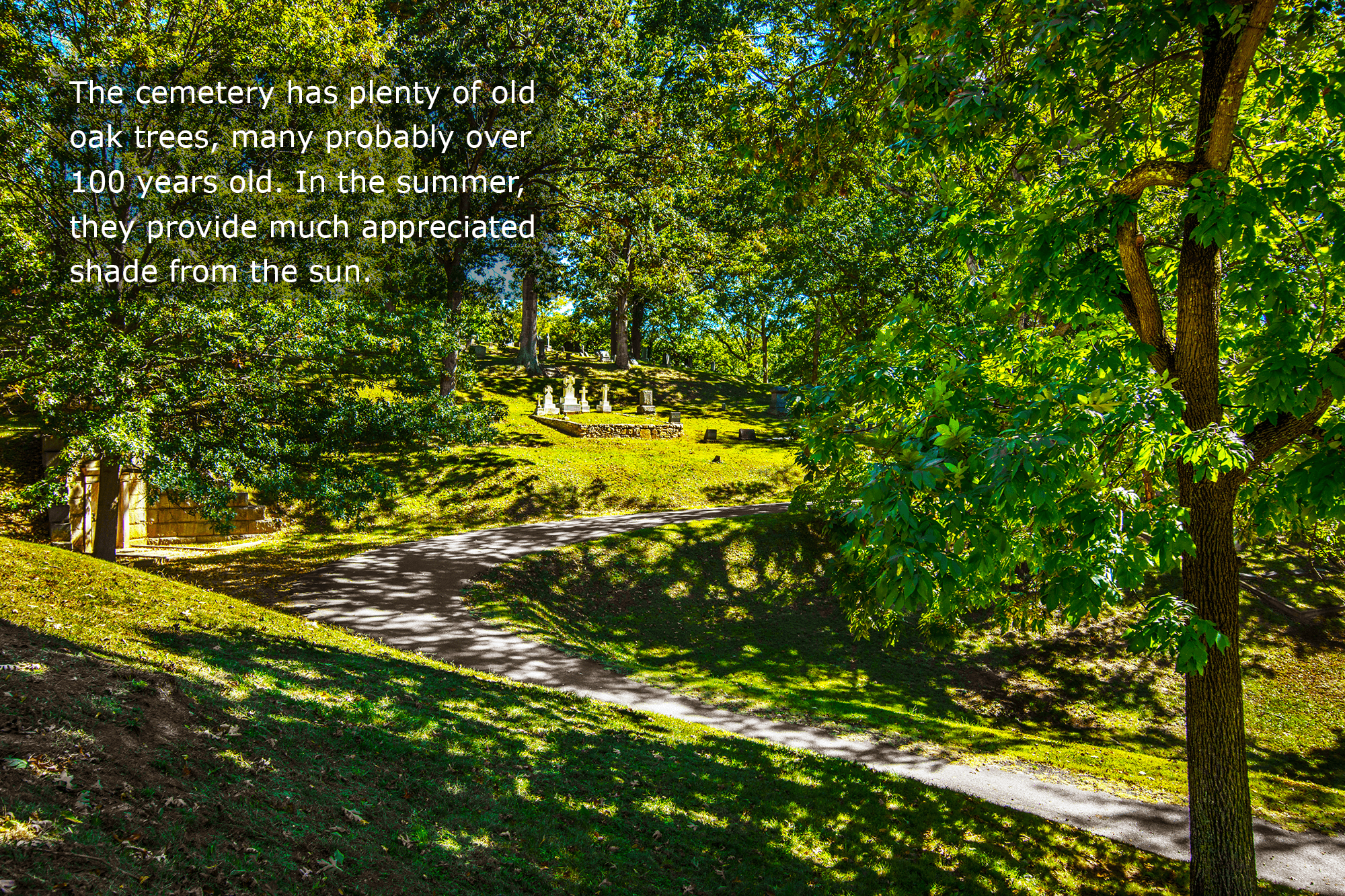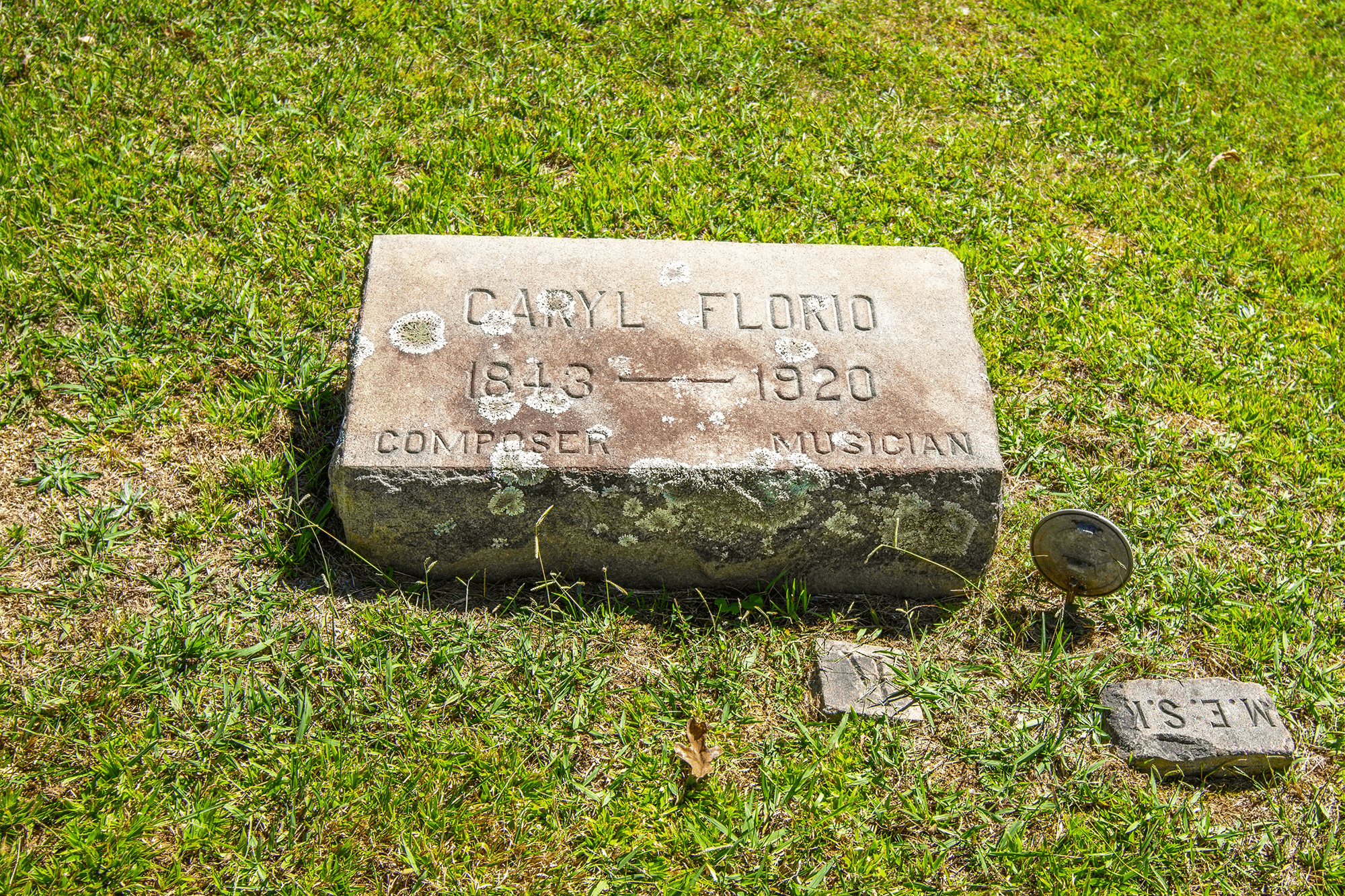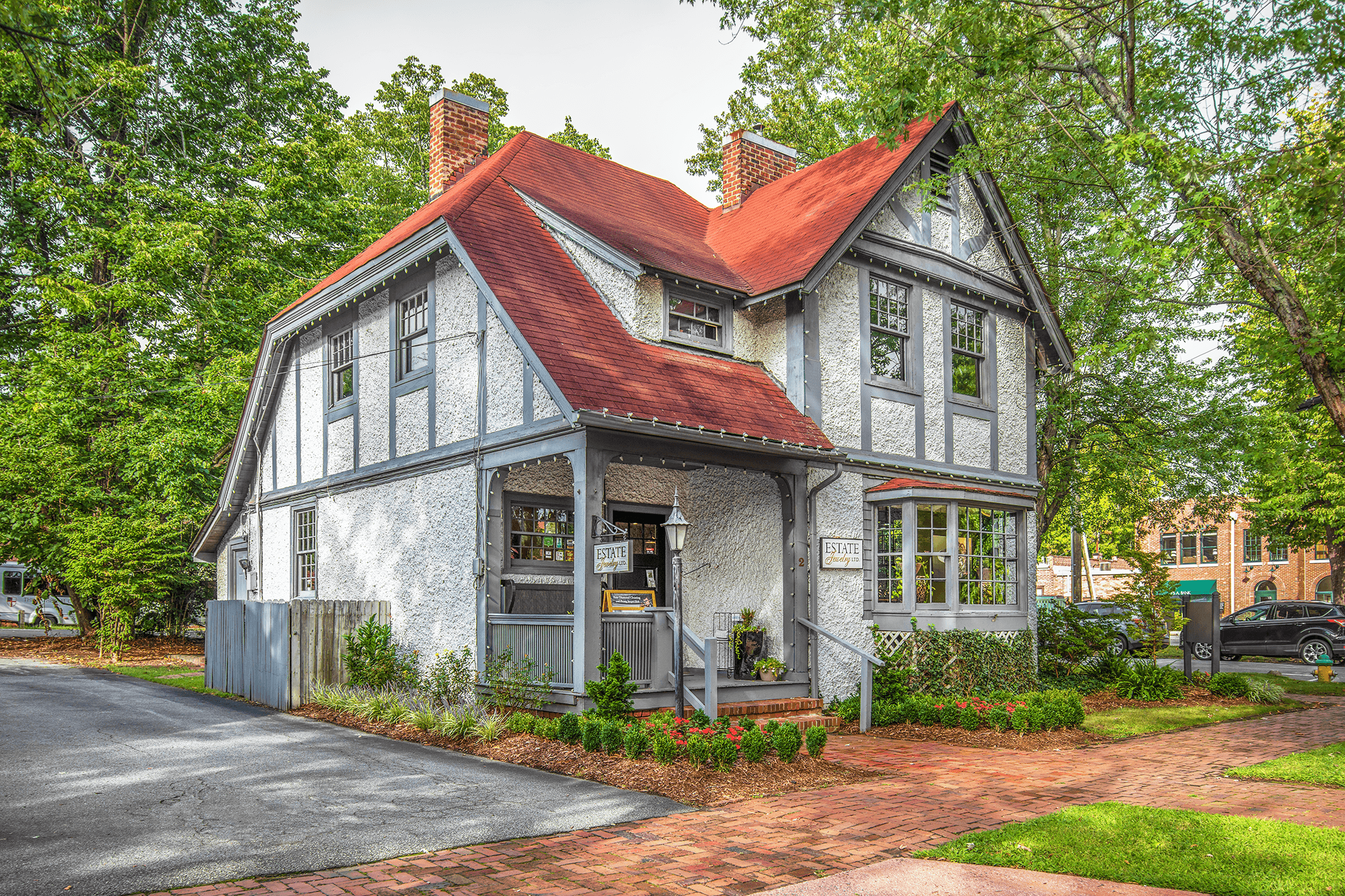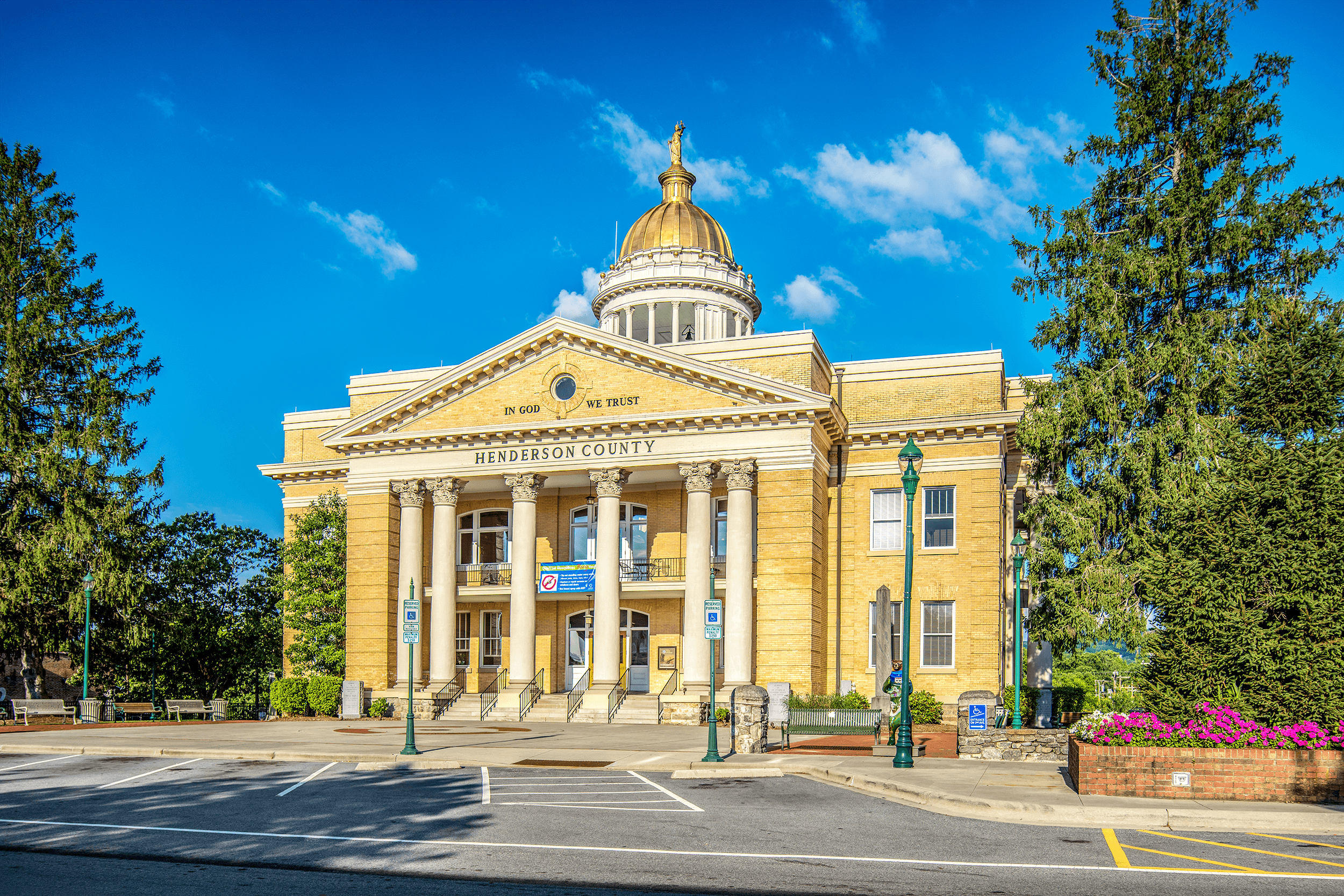Riverside Cemetery

Updated: April 2019
A Journey Back Through History
The Riverside Cemetery is located in the historic Montford District at the end of Birch Street. It was founded on August 4, 1885, as a garden-style cemetery, which would serve as a burial ground but also as a public park. It encompasses 87 acres of rolling hills and flower gardens overlooking the French Broad River.
The Riverside Cemetery is the final resting place of renowned authors Thomas Wolfe and America’s famous short-story writer O. Henry. Also buried at the cemetery are Zebulon Vance, three Civil War Confederate Generals, two U.S. Senators, Biltmore Estate’s supervising architect Richard Sharp Smith, many of Asheville’s founding families and the remains of 18 German soldiers from the First World War.
Today, the Riverside Cemetery is still an active cemetery and holds approximately 50 services each year. More than 13,000 people have been buried at the cemetery. There are around 9,000 monuments and 12 family mausolea.
Historic Montford
Thomas Wolfe (1900-1938) was North Carolina’s most famous writer. He is also considered one of the major American novelists of the early 20th century and “one of the first masters of autobiographical fiction”.
Thomas Wolfe (1900-1938)
Grave: Section Q, Lot 1, Grave #6.
Thomas Clayton Wolfe (1900-1938) is considered one of the major American novelists of the early 20th century and North Carolina’s most famous writer. He was “one of the first masters of autobiographical fiction”.
In his book Look Homeward, Angel (1929), Thomas Wolfe traces his own early life in the character of Eugene Grant, who leaves his small town Altamont, Catawba (believed to be Asheville, North Carolina), and his dysfunctional family in search for a better life trying to quench his intellectual thirst and wanderlust. In his book, Thomas Wolfe described real characters from Asheville, which caused him some difficulties, when he and his family were banned from the local library.
In his book, the boarding house Dixieland is believed to represent the boarding house, which his mother Julia Elizabeth Westall Wolfe (1860-1945) operated, and where Thomas Wolfe grew up. Today, the boarding house has been turned into The Thomas Wolfe Memorial.
His parents, William Oliver Wolfe (1851-1922) and Julia Elizabeth Westall Wolfe (1860-1945) are also buried at the Riverside Cemetery in graves #5 and #7.
The life of O. Henry was as twisted as the short stories, which made him famous. O. Henry was the pen name of William Sydney Porter (1862-1910), which he used during his time in prison for embezzlement. In 1902, after serving three years, he moved to New York City and started to write one short story every week, totaling 381. His wit, characterization and plot twists were admired by many. Beside William’s grave rests his wife Sallie - Sara Coleman Porter.
William Sydney Porter “O. Henry” (1862-1910)
Grave: Section K, Lot 51, Grave #1.
The life story of William Sydney Porter, better known by his pen name O. Henry, is as remarkable as the twists and turns in his short stories. He lived a life of extremes. Sometimes he was on the top and sometimes he was on the bottom. During the height of his career, editors would beg him for stories. However, he had also been convicted for embezzlement and served a prison term. Here is his incredible story:
William Sydney Porter was born in Greensboro NC. When William was three, his mother Jane died from tuberculosis. He and his father, Dr. Algernon Sidney Porter (1825-1888), who was a physician, moved into the home of his father’s mother. William’s aunt Evelina Maria Porter raised him. In 1879, at the age of 17, he started working in his uncle’s drugstore and received his pharmacist license two years later in 1881.
In 1882, after having developed a persistent cough, William traveled with Dr. James K. Hall to Texas, where he stayed at the ranch of Dr. Hall’s son Richard and helped out as a shepherd, ranch hand, cook and babysitter.
By 1884, his health had improved, and he traveled with Richard to Austin TX. He liked the city and decided to remain, staying with friends of Richard’s. During these years, he met Athol Estes, who came from a wealthy family. Even though Athol suffered from tuberculosis, she and William ran away and secretly married.
After William’s friend Richard became Texas Land Commissioner in 1887, he offered William a job as a draftsman. On the side, he also contributed articles to magazines and newspapers. In 1889, William and Athol’s daughter, Margaret Worth Porter, was born.
William’s job at the Texas General Land Office was considered a political appointment, which his friend Richard had organized for him. When Richard was not elected governor of Texas in 1890, William resigned in 1891 from his position and started working at the First National Bank of Austin as a teller and bookkeeper.
During his time at the bank, he worked on his humorous weekly The Rolling Stones, which received some local attention but only achieved a maximum circulation of 1,500.
In 1894, William was charged with embezzlement and lost his job at the bank. He was never indicted. To this day, it is not entirely clear, whether William committed the crime, or whether he was blamed for the crimes of his superiors. He said in his own words:
“I took the job and held a position of trust. [...] Since I did not report the shortages as they occurred, I can legally be held as an accessory to the fact.”
In 1895, William and his family moved to Houston, where he started to work at the Houston Post. Although his income was low, his popularity increased.
While working at the Houston Post, federal auditors checked the books of the First National Bank of Austin and found the embezzlement shortages that had let to him losing his job at the bank. William was indicted and arrested on charges of embezzlement. His father-in-law posted bail to keep William out of jail. His trial date was set to July 7, 1896. One day before his trial, fearing its outcome and seemingly on impulse, he fled, first to New Orleans and then to Honduras, with which the U.S. did not have an extradition treaty. Athol and their daughter Margaret returned to Austin to live with Athol’s parents.
During that time, Athol’s health worsened, and she became too ill to travel to Honduras to meet William. When he learned that Athol was dying, William decided to return to Austin in 1897 and surrendered to the court, pending an appeal. William’s father-in-law posted bail again, for William to stay with his wife Athol and his daughter Margaret. Athol died of tuberculosis in July of 1897.
During his trial, William did not bring much to his defense. He was found guilty of embezzlement in February of 1898 and sentenced to 5 years in prison. As William was a licensed pharmacist, he was able to work in the prison hospital as the night druggist, staying in his room in the hospital wing. While in prison, he published 14 stories under various pseudonyms. Among them was O. Henry, for which he became best known. In 1901, after serving three years, William was released on good behavior and quickly reunited with his daughter Margaret.
In 1902, William moved to New York City to be close to his publishers. For over a year, he wrote a story a week for the New York World Sunday Magazine. While in New York City, William wrote a total of 381 short stories, and his wit, characterization and plot twists were admired by many. However, he also developed a heavy drinking habit and later diabetes.
In 1907, William married Sara “Sallie” Lindsey Coleman, his childhood sweetheart, in Asheville at the home of Sara’s brother James. The couple spent their 10-day honeymoon in Hot Springs NC, probably in The Mountain Park Hotel, a famous resort hotel. After their honeymoon, William and Sara moved to New York City.
It may have been trying for William to change his bachelor ways and he continued to drink and live an expensive lifestyle. His health deteriorated markedly, which impacted his writing. His doctor diagnosed him with severe diabetes and gave him only two more years to live. In 1909, Sara left him and returned to her parent’s home in Asheville.
William Sydney Porter died in New York City on June 5, 1910, at the age of 48, of cirrhosis of the liver, diabetes and an enlarged heart. After the funeral services, Sara chose to have him buried at the Riverside Cemetery in Asheville.
Born in 1889, Margaret was William’s and Athol’s only daughter. Athol, William’s first wife, died of tuberculosis in 1897.
Born in Weaverville NC, just north of Asheville, Zebulon Vance was elected Governor of North Carolina twice and served in the United States Senate from 1879 to 1894.
Zebulon Baird Vance (1830-1894)
Grave: Section B, Lot 13, Grave #3.
Zebulon Baird Vance was born in 1830 near present-day Weaverville NC, just north of Asheville. His birthplace home, a log mountain cabin, can still be visited today (→ Vance Birthplace)
In 1862 Zebulon Vance became Governor of North Carolina for the first time, but was arrested by Federal forces during the American Civil War and later pardoned by President Andrew Johnson. After his release, he went to Charlotte to practice law. In 1870, the North Carolina legislature elected him to the United States Senate, but as an ex-Confederate, he was not allowed to serve. Then in 1876, Zebulon Vance was elected Governor of North Carolina for the second time. Three years later, the legislature elected him to the United States Senate, which he served until his death in 1894.
In 1896, two years after his death, an obelisk in his honor was erected in Pack Square Park in Asheville, the Vance Memorial.
Richard Sharpe Smith was probably one of the most productive architects in Asheville in the early 1900s. He was first George Vanderbilt’s personal architect during the construction of Biltmore Estate, but in 1901 opened his private practice in Asheville and then in 1906 formed a partnership with Albert Carrier. In the following almost 20 years until Smith’s death, the firm worked on over 700 projects.
Richard Sharpe Smith (1852-1924)
Grave: Section S, Lot 115, Grave #6.
Richard Sharpe Smith, sometimes also spelled Richard Sharp Smith, was probably one of the most productive architects in Asheville and its surroundings during the building boom of the early 1900s. After his role as supervising architect for the Biltmore Estate and after the death of Richard Morris Hunt in 1895, he became George Vanderbilt’s personal architect. In 1901, he started his private practice in Asheville, and 1906 formed a partnership with Albert Heath Carrier. Through this partnership and until Richard Smith’s death in 1924, the Smith and Carrier firm worked on over 700 projects. The following is a short overview of his life:
Richard Sharpe Smith was born in Yorkshire, England in 1852. He received his architectural training in the office of his cousin George Smith. He also worked for several architects in Manchester.
In 1882, Richard Smith immigrated to the U.S. and started his new position with the Reid Brothers, architects, in Evansville, Indiana.
One year later, in 1883, Richard Smith moved to New York City and joined Bradford L. Gilbert’s office, where he supervised the design and construction of railroad stations.
In 1886, he joined the office of Richard Morris Hunt and worked on several projects for him.
In 1889, Richard Hunt assigned him to the Biltmore Project, supervising the construction of → Biltmore House and other buildings on George Vanderbilt’s estate. Richard Smith was sent to Biltmore and communicated with Richard Hunt, who remained in his New York office, through weekly progress reports and frequent letters.
Starting in 1892, George Vanderbilt asked Richard Smith to design additional buildings for him.
In 1895, the same year, when → Biltmore House was finished, Richard Hunt suddenly died, and Richard Smith became George Vanderbilt’s personal architect.
In 1896, the Vance Memorial, which Richard Smith had designed, was completed.
By 1901 the first cottages in the Cottage District in Biltmore Village were built.
In 1901, Richard Smith established his private practice in fast-growing Asheville. Through his abilities as an architect and indeed through his association with George Vanderbilt, Richard Smith became one of Asheville’s leading architects, and the first, who resided permanently in the city. During this time, Richard Smith designed the Henderson County Courthouse in Hendersonville (1905) and together with Rafael Guastavino the Basilica of Saint Lawrence (1905-1909).
In the historic Montford District, Richard Smith is credited with designing the Mary S. Wolcott House in 1899, today the → Black Walnut B&B and Inn, the Dr. Charles S. Jordan House in 1900, today home of the → 1900 Montford Inn, the Maria T. Brown House in 1901, which is today the → Carolina B&B and the Wythe Peyton House in 1908, today the → Abbington Green B&B Inn.
In 1906, Richard Smith formed a partnership with Albert Heath Carrier, whose family had moved to Asheville in 1885, and formed the Smith and Carrier firm. Together the firm worked on more than 700 projects from its inception to Richard Smith’s death in 1924. Some of their essential works were the Legal Building (1909), the Scottish Rite Cathedral and Masonic Temple (1913), the Fraternal Order of Eagles Building (1914), the Elks Home (1915) and the Loughran Building (1923).
Richard Smith died in 1924. He was praised by the local newspaper Asheville Citizen to have “done more than any other person to beautify the city.”
William Henry Lord is considered as one of the most influential architects in Asheville during the building boom in the early 1900s. He constructed many commercial buildings and private residences.
William Henry Lord (1864-1933)
Grave: Section K, Lot 116, Grave #4.
William Henry Lord is regarded as one of the most influential architects in Asheville during the early 1900s. He was born in Syracuse NY, where he started his career as an architect. Later he worked for the U.S. Government, supervising building construction across the country.
His wife Helen, whom he had married in 1896, had some family connection to the prominent Asheville physician Dr. Samuel Westray Battle, who was also well connected with George Vanderbilt and Richard Sharpe Smith. It is said that Richard Smith encouraged William Lord and his wife to move to Asheville, which they did in 1899. Around 1902, one of William Lord’s first significant commissions was the design of the extension to the Clarence Barker Memorial Hospital.
Helped by the building boom in Asheville, Henry Lord constructed many commercial buildings and private residences, such as the 1912-built John Adams Perry House, today home of the → Applewood Manor B&B in the historic Montford District.
Caryl Florio was William James Robjohn’s pen-name. He was a famous composer, organist, and pianist and between 1896 and 1901 was the musical director at The Cathedral of All Souls in Biltmore Village.
Caryl Florio (1843-1920)
Grave: Section S1, Lot 70, Grave #9.
William James Robjohn, better known under his pen-name Caryl Florio, was a famous composer, organist, and pianist. He was born in Tavistock, Devonshire UK. He taught himself music against the opposition of his parents, even though his father was an organ builder. In 1857, his family immigrated to the U.S. and came to New York City. Between 1858 and 1860, he was the first boy soprano singer at the Trinity Church in New York City NY.
In 1872 at the age of 29, he took the pseudonym Caryl Florio. He produced his own opera Uncle Tom in 1881 and between 1896 and 1901 was the musical director at All Souls’ Church in Biltmore Village, today’s The Cathedral of All Souls.
He returned to New York City in 1901 but moved back to Asheville two years later in 1903, where he taught choruses and choirs.
Nearly all his works appeared under his pen-name Caryl Florio.
In January 1920, William Robjohn became a psychiatric patient at the Appalachian Hall Sanitorium at South French Broad Avenue in Asheville, not to be confused with the Kenilworth Inn, which in 1931 was renamed Appalachian Hall and was a psychiatric facility specializing in alcohol addictions.
He then transferred to the State Hospital in Morganton NC in March of 1920 at the age of 77, where he later died in November of that year.
When the U.S. entered WWI in 1917, German and Austrian commercial ships with passengers, officers and crew members were seized along the entire east coast. Some 2,500 German and Austrian noncombatants were interned at The Mountain Park Hotel in Hot Springs. During this period, 18 German sailors passed away from typhoid fever and were buried at the Riverside Cemetery.
WWI German “Prisoners of War”
Grave: Section M, Lot 77.
James Edwin Rumbough (1861-1941), who at that time was living in today’s Rumbough House in the historic Montford District, was an early automobile enthusiast. In 1905, he was the first motorist to drive from Asheville to New York City, a journey of 14 days, and in 1911 across the Appalachian Mountains into Tennessee.
In 1913, despite having other interests on his mind, he purchased the famous resort hotel The Mountain Park Hotel in Hot Springs NC from his father. He tried to lease the property in 1915, only to take it back just a couple of months later when the contract fell apart. In 1917, another opportunity arose.
That year the U.S. entered the First World War and German and Austrian commercial ships with passengers, officers and crew members were seized by the U.S. Government along the entire east coast. Among the 30 captured ships was the steamship Vaterland, at 909 feet (277 m) the largest ship in the world at that time. The Vaterland was renamed Leviathan and continued as a troopship and then as the flagship of the United States Lines. There were thousands of passengers, officers and crew members “stranded” along the sea coast and the U.S. Government was looking for a place to bring them all together. This place became Hot Springs after James Edwin had successfully negotiated a contract with the U.S. Government to lease them the grounds and the hotel for $1,500 per month.
Soon 2,500 German and Austrian internees arrived by train in Hot Springs, a tiny village of only 650. Although barbed wire was strung up around the complex, security was relatively relaxed, since the “prisoners” were noncombatants. The officers of the vessels were put into The Mountain Park Hotel, while the women found rooms in town. It is reported that they were excellent dressmakers and sewed for the townspeople. The brass band of the Vaterland practiced every day and gave concerts for the townspeople every Sunday afternoon. The barracks were taken down soon after the First World War ended in November of 1918.
Many of the former “prisoners”, who had built close friendships with the townspeople, returned after the war to visit Hot Springs with their families.
While interned in Hot Springs NC, eighteen German sailors died from contracting typhoid fever and were then buried at the Riverside Cemetery.
Dr. Karl von Ruck was one of the leading doctors and scientists of tuberculosis in Asheville. Studied under Rudolf Virchow in Berlin, Germany, von Ruck opened the Winyah Sanatorium in Asheville in 1888, which was solely dedicated to the treatment of tuberculosis.
Dr. Karl von Ruck (1849-1922)
Grave: Section Q, Lot 14, Grave #4.
Dr. von Ruck’s name is tightly connected with Asheville as the center for tuberculosis treatment.
In 1871, Dr. H. P. Gatchell, one of the pioneers of treating tuberculosis in Asheville, opened The Villa in today’s Kenilworth neighborhood. The Villa was a sanatorium exclusive for tuberculosis patients. It was the first of its kind in the entire U.S. At that time it was believed that “an optimum combination of barometric pressure, temperature, humidity and sunlight” was conducive to healing tuberculosis.
When the railroad arrived in Asheville in 1880, the number of tourists and patients increased sharply, prompting the construction of hotels, boarding houses, and later more sanatoria. Asheville became a sought after destination, including very wealthy families, such as George Vanderbilt, Edwin Grove, and many others. Among them were also many doctors, such as Dr. Samuel Westray Battle (1854-1927), who came to Asheville after retiring from active naval service in 1884. Dr. Battle then grew to become one of Asheville’s most respected physicians and in 1900 the medical director of George Vanderbilt’s Clarence Barker Memorial Hospital in Biltmore Village.
Dr. Karl von Ruck arrived in Asheville shortly after Dr. Battle in 1886.
Dr. von Ruck was born in 1849 in today’s Istanbul, Turkey, as the son of a German diplomat. He spent his early life in Stuttgart, Germany. He graduated from medical school in 1877, followed by a medical degree from the University of Michigan in 1879. Dr. von Ruck conducted his post-graduate studies in Berlin, Germany, with the renowned scientists Rudolf Virchow (1821-1901) and Robert Koch (1843-1910). He was even present at the memorable meeting of the Berlin Physiological Society in March of 1882, when Robert Koch, a future Nobel Prize winner, announced the discovery of the tubercle bacillus and a method of growing it in pure culture.
Back in the U.S., Dr. von Ruck decided to focus his work on tuberculosis and moved to Asheville in 1886 to establish the Winyah Sanatorium in 1888, which was solely dedicated to the treatment of tuberculosis. Influenced by the work of Robert Koch and others, Dr. von Ruck concluded that the control of tuberculosis would need to come through biological treatment and immunization of children.
In 1895, he formed the von Ruck Research Laboratory for Tuberculosis. In 1897 he introduced his first watery extract of the tubercle bacillus, which was a modification of Robert Koch’s first tuberculin, which he brought back to the U.S. from a trip to Berlin, Germany. Dr. von Ruck spent many more years of research trying to perfect an immunization preparation, which would be able to eradicate this terrible disease.
With his son Silvio stepping into his father’s footsteps and becoming medical director of the Winyah Sanatorium in 1910, it allowed Dr. von Ruck to devote all his time to his research.
In 1912, he brought out a first vaccine, with which he was hoping to immunize children.
In 1918, his son Silvio died unexpectedly of pneumonia, followed by his son’s only daughter Silvia a few days later. These terrible losses forced Dr. von Ruck to take charge of the Winyah Sanatorium again. Only three years later in 1921, his wife also died. Devastated by her death and himself desperately fighting against the inroads of chronic nephritis, a complex kidney disease, and hypertension, Dr. von Ruck died in November of 1922. He is remembered as one of the leading pioneers in tuberculosis and one of the outstanding figures in the history of tuberculosis in the U.S. His magnificent home, the → Dr. von Ruck House, can still be seen to this day.
Finally, the tuberculosis vaccine was successfully developed in 1921 by two French scientists, Albert Calmette and Camille Guérin, after 13 years of research. They named it Bacillus Calmette-Guérin or BCG. It is administered to infants shortly after birth.
Solomon Lipinsky was known for his immense dedication and contribution to the community. He believed in giving back and leaving a positive impact on the city and its citizens. He also owned one of the largest department stores in all of North Carolina.
Solomon Lipinsky (1856-1925)
Grave: Beth Ha-Tephila Cemetery.
Solomon Lipinsky was known for his immense dedication and contribution to the community. He believed in giving back and leaving a positive impact on the city and its citizens. He also owned one of the largest department stores in all of North Carolina.
Solomon Lipinsky was born in Richmond VA and moved to Tarboro NC in 1877, where he met and married Eva Whitlock. In 1881, the couple moved to Asheville, where Solomon started to work as a clerk at a local store owned by his brother-in-law.
By 1887, Solomon Lipinsky owned a dry-goods store, Lipinsky and Ellick, together with his half-sister Eva Ellick. By 1911, Asheville was booming and his business, now the Bon Marché, was rapidly growing, and he decided to move his store to the northwest corner of Patton Avenue and Lexington Avenue, the current Kress Building.
The Bon Marché continued to grow, and the current location became too small again. Around 1923, Edwin Grove commissioned architect William Stoddart to design a larger building for his friend Solomon Lipinsky based on Solomon’s specifications and using the best fireproof materials available at that time.
The new Bon Marché Department Store on Haywood Street was a sensation in Asheville. It had four floors full of merchandise, tasteful decorations and a hydraulic elevator, which at that time was the first in a public building in North Carolina.
Driven by this success, more locations opened in Charlotte NC, Wilmington NC, and Columbia SC. The Bon Marché Department Stores were a family business, and his sons managed most locations.
The Bon Marché Department Store also sponsored radio broadcasts and invited famous designers and make-up artists. Solomon Lipinsky also provided training to his employees to enable them to succeed in their jobs.
The Buchanan Angel statue was carved entirely from limestone left over from the construction of the Biltmore Estate. It was cut by English stone carver Fred Miles, who worked at Biltmore Estate during its construction.
Buchanan Angel
Grave: Section B/C, Lot 1.
The Buchanan Angel statue was carved entirely from limestone left over from the construction of the Biltmore Estate. It was cut by English stone carver Fred Miles, who worked at Biltmore Estate during its construction.
After his work on the Biltmore Estate had ended, Fred Miles was contracted by Allen Melton, the architect of the → Drhumor Building in downtown, to create a distinct limestone frieze above the first floor of his building. Some of the faces that Fred Miles had carved are believed to represent residents of the era.
53 Birch Street, Asheville, NC 28801
Tel.: → (828) 350 2066
Cemetery:
November to March:
Mon. to Sun.: 7am to 6pm
April to October:
Mon. to Sun.: 7am to 9pm
Office:
Mon. to Fri.: 8am to 4:30pm
All year.
Free admission.
Free parking available inside the cemetery.
Public bus stop: Montford Ave at Cullowhee St.
As the main roads are paved, the cemetery is accessible with a stroller.
As the main roads are paved, the cemetery is accessible by wheelchair.
Restrooms are located at the office.

